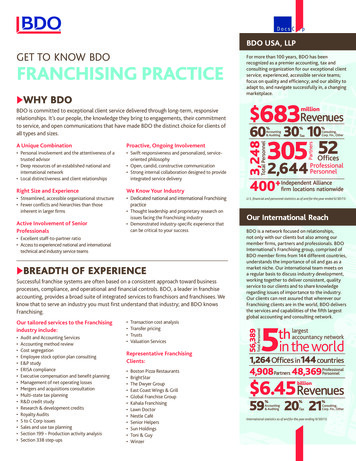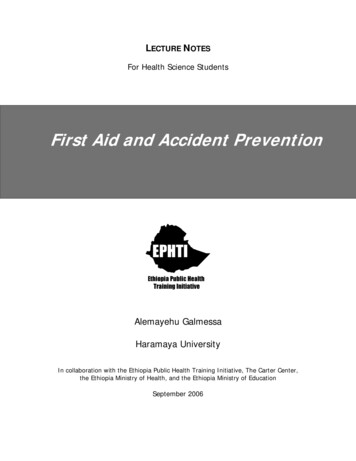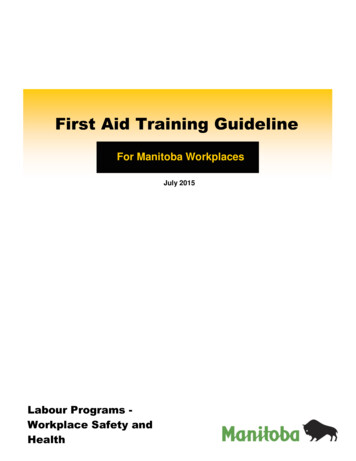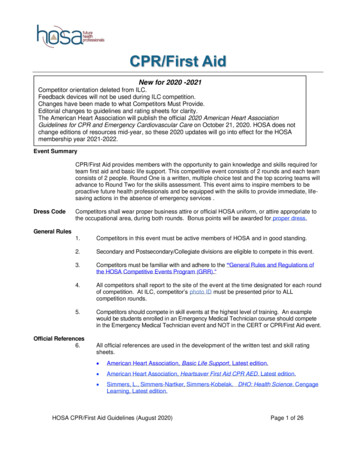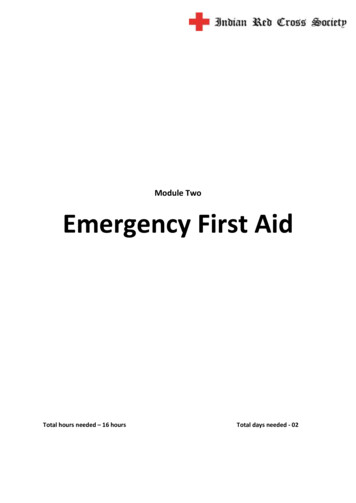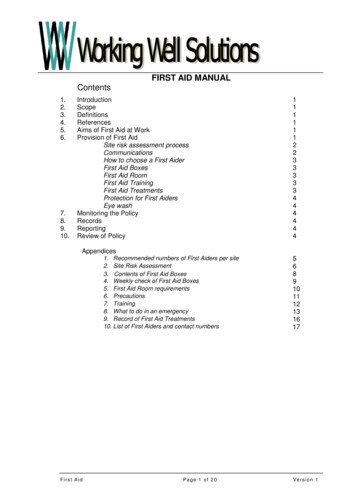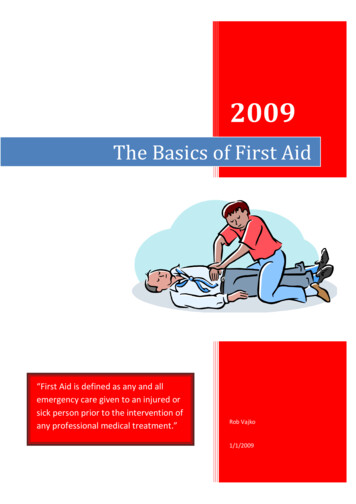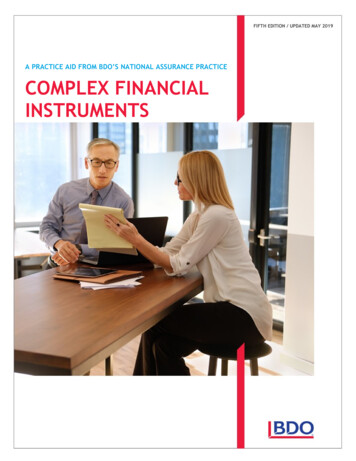
Transcription
Significant Accounting & Reporting Matters Second Quarter 2011 1FIFTH EDITION / UPDATED MAY 2019A PRACTICE AID FROM BDO’S NATIONAL ASSURANCE PRACTICECOMPLEX FINANCIALINSTRUMENTSBDO is the brand name for BDO USA, LLP, a U.S. professional services firm providing assurance, tax, and advisory services to a wide range of publiclytraded and privately held companies. For more than 100 years, BDO has provided quality service through the active involvement of experienced andcommitted professionals. The firm serves clients through more than 60 offices and over 650 independent alliance firm locations nationwide. As anindependent Member Firm of BDO International Limited, BDO serves multi-national clients through a global network of more than 80,000 peopleworking out of nearly 1,600 offices across 162 countries and territories.BDO USA, LLP, a Delaware limited liability partnership, is the U.S. member of BDO International Limited, a UK company limited by guarantee, andforms part of the international BDO network of independent member firms. BDO is the brand name for the BDO network and for each of the BDOMember Firms. For more information please visit: www.bdo.com. 2019 BDO USA, LLP. All rights reserved.
Complex Financial Instruments Practice Aid – 5th EditionTABLE OF CONTENTSBackground and Purpose . 3This is the fifth edition of the Practice Aidwhich has been updated to May 2019.Redeemable Preferred Stock, Warrants for Redeemableand Puttable Warrants . 5HOW TO USE THE PRACTICE AIDEmbedded Conversion Options. 9The Practice Aid includes detailed flowchartsfor analyzing embedded conversion options,freestanding warrants, and embedded putsand calls. Each step in the flowchart isexplained in detail in the Practice Aid. Aseach step is explained, the flowcharts arerepeated, and your location in the overallflowchart is identified. We recommend thatyou begin your analysis with the flowchartand then start your extended analysis in theappropriate sections of the Practice Aid. Weencourage you to utilize the flowchartsflexibly – in some circumstances it might bemore efficient to begin the analysis ofembedded conversion options at Step C.Warrants . 58Puts and Calls Embedded in Debt . 62Electing the Fair Value Option . 68Balance Sheet Classification of Shares . 69Allocation of Proceeds and Journal Entries . 72Earnings Per Share. 75Deferred Income Taxes . 88Debt Issue Costs, Debt Discount or Premium, andPreferred Stock Discounts . 89Conversion Accounting and Changes in ConversionOption Accounting After Issuance . 91Troubled Debt Restructuring, Debt ModificationExtinguishment . 95FLOWCHARTSEmbedded Conversion Options. 9Warrants . 58Puts and Calls Embedded in Debt . 63To ensure compliance with Treasury Department regulations,we wish to inform you that any tax advice that may becontained in this communication (including any attachments)is not intended or written to be used, and cannot be used,for the purpose of (i) avoiding tax-related penalties underthe Internal Revenue Code or applicable state or local taxlaw provisions or (ii) promoting, marketing or recommendingto another party any tax-related matters addressed herein.Material discussed in this publication is meant to providegeneral information and should not be acted on withoutprofessional advice tailored to your individual needs.Shares Classification . 69BDO is the brand name for BDO USA, LLP, a U.S. professional services firm providing assurance, tax, and advisory services to a wide range of publiclytraded and privately held companies. For more than 100 years, BDO has provided quality service through the active involvement of experienced andcommitted professionals. The firm serves clients through more than 60 offices and over 650 independent alliance firm locations nationwide. As anindependent Member Firm of BDO International Limited, BDO serves multi-national clients through a global network of more than 80,000 peopleworking out of nearly 1,600 offices across 162 countries and territories.BDO USA, LLP, a Delaware limited liability partnership, is the U.S. member of BDO International Limited, a UK company limited by guarantee, andforms part of the international BDO network of independent member firms. BDO is the brand name for the BDO network and for each of the BDOMember Firms. For more information please visit: www.bdo.com. 2019 BDO USA, LLP. All rights reserved.2
Complex Financial Instruments Practice Aid – 5th Edition3BACKGROUND AND PURPOSEAS THE DESIGN OF FINANCIAL INSTRUMENTS CONTINUES TO EVOLVE,PUBLIC AND PRIVATE COMPANIES HAVE INCREASINGLY ENTERED INTOCREATIVE FINANCING TRANSACTIONS.These transactions often involve the issuance of conversion options embedded in debt or preferred shares (such as convertibledebt or convertible preferred shares) and freestanding warrants to purchase the issuer’s shares. We have received manyquestions about accounting for these types of transactions. The SEC staff frequently questions whether the appropriateaccounting analysis has been performed, and as a result of these questions a number of companies have restated prior financialstatements. The purpose of this document is to summarize the GAAP that applies to issuers of convertible securities,freestanding warrants, and puts and calls, and to discuss other common issues that should be considered in debt and equityfinancings.Companies should begin the analysis by identifying the financial instruments issued. For example, a company may have issuedone instrument with embedded conversion options or two freestanding instruments (e.g., nonconvertible debt with detachablewarrants). It is important that companies read the contracts thoroughly to identify all of the terms that may require recognitionin the financial statements. Companies are faced with additional challenges if the terms of a financing are scattered in severaldifferent agreements. For example, a capital raising transaction frequently includes a securities purchase agreement, a warrantagreement, and a registration rights agreement.Initially, companies should determine whether the instruments they issued are considered freestanding or embedded, i.e.,combined with another contract. This determination is a matter of judgment. Accordingly, the following questions should beconsidered: Was one contract issued in contemplation of and simultaneously with another contract? For example, werenondetachable warrants issued in conjunction with debt?Can the holder of the contracts sell, transfer and/or exercise each contract separately? For example, must the debt betendered in order to exercise the warrants?Were the contracts executed with the same counterparty either directly or through an intermediary?Do the contracts or transactions relate to the same risk?Is there an apparent economic need or substantive business purpose for structuring the transactions separately thatcould not also have been accomplished in a single transaction?Different accounting conclusions may be reached based on whether contracts are evaluated separately or as a single combinedunit. As such, this decision must be made prior to identifying the appropriate literature to apply. In particular, ASC 480-10applies only to freestanding instruments, whereas ASC 815 provides guidance for hybrid instruments, i.e., contracts comprised ofa host such as a debt instrument and an embedded feature such as a conversion option.After reading the contracts and identifying the financial instruments, companies should answer the following questions that arediscussed in detail in this Practice Aid for each instrument:1.Is the freestanding financial instrument a mandatorily redeemable preferred stock, a warrant for redeemable stock, or aputtable warrant, i.e., is it within the scope of ASC 480-10?
Complex Financial Instruments Practice Aid – 5th Edition2.4Does the financial instrument include embedded conversion options?If so, is the issuer required to bifurcate the conversion option from the host contract under ASC 815-15? That is,a. Are the economic risks and characteristics of the embedded conversion options clearly and closely related to theeconomic risks and characteristics of the host contract? If yes, bifurcation is not required.b. Is the hybrid instrument (i.e., the contract comprising the host and the embedded conversion options)remeasured to fair value at each balance sheet date with changes reported in earnings? If yes, bifurcation is notrequired.c. Would the embedded conversion option, if freestanding, qualify as a derivative under ASC 815-10? If no,bifurcation is not required.Does the embedded conversion option meet the ASC 815-10-15-74 scope exception? If the answer to each of thefollowing questions is yes, derivative accounting is not required. That is,d. Is the embedded conversion option indexed to the company’s own stock under ASC 815-40-15;e. Can the embedded conversion option be classified in shareholders’ equity under ASC 815-40-25-1 through 6; andf. If the hybrid instrument is convertible, is it conventional convertible; or, if it is not conventional convertible,can the embedded conversion option be classified in stockholders’ equity under ASC 815-40-25-7 through 25-35?3.Is the financial instrument a freestanding warrant?If so, does the warrant meet the ASC 815-10-15-74 scope exception? If the answer to each of the following questions isyes, the warrant can be accounted for in equity. That is,a. Is the freestanding warrant indexed to the company’s own stock under ASC 815-40-15;b. Can the freestanding warrant be classified in shareholders’ equity under ASC 815-40-25-1 through 6; andc. Can the freestanding warrant be classified in stockholders’ equity under ASC 815-40-25-7 through 35?4.Does the financial instrument include embedded puts and/or calls or other features that require bifurcation from thehost contract under ASC 815?5.Has the fair value option been elected for a hybrid instrument?6.What is the appropriate balance sheet classification of contingently redeemable shares?7.How are the proceeds from the capital raising transaction allocated and what are the journal entries?8.How do you calculate diluted earnings per share for issuers with potential common shares represented by conversionoptions and warrants?9.Are deferred income taxes required?10. How and over what period are debt issue costs and debt discounts or premiums amortized?11. What is the appropriate accounting and journal entries for conversions of debt or preferred stock instruments intocommon stock and for accounting after original issuance?12. What is the accounting for troubled debt restructurings, debt extinguishments and debt modifications?These questions will be addressed in-depth and analyzed in the context of examples and case studies for R Company.
Complex Financial Instruments Practice Aid – 5th Edition5REDEEMABLE PREFERRED STOCK,WARRANTS FOR REDEEMABLE PREFERREDSTOCK, AND PUTTABLE WARRANTSSTEP A: IS THE FINANCIAL INSTRUMENT WITHIN THE SCOPE OF ASC 48010?Freestanding Financial InstrumentsStep A in analyzing a complex financial instrument is to determine whether it falls within the scope of ASC 480-10. The followingthree categories of freestanding financial instruments are required to be accounted for as liabilities under ASC 480-10: Mandatorily redeemable shares; Instruments (other than an outstanding share) that do or may obligate the issuer to buy back some of its shares (or areindexed to such an obligation) in exchange for cash or other assets — e.g., written puts (puts written by the issuer on itsown shares and held by others); and Obligations that must or may be settled with a variable number of shares the monetary value of which is based solely orpredominantly on —oA fixed monetary amount known at inception;oA variable other than the fair value of the issuer’s shares such as a market index; oroA variable inversely related to the fair value of the issuer’s shares.The second category of instruments falls under ASC 480-10, but is not germane to the analysis of shares. If the shares do fall intocategories one or three, they are measured initially at fair value. If the shares do not fall into categories one or three, theinstruments must be analyzed under ASC 815.Category One – Mandatorily Redeemable SharesMandatorily redeemable shares are shares that an entity is required to redeem for cash or other assets at a fixed or determinabledate or upon an event that is certain to occur. 1 Mandatorily redeemable shares should be measured subsequently in one of twoways:1 For instruments issued by nonpublic companies that were mandatorily redeemable on fixed dates for fixed amounts or by reference to an interest rate index, currency index,or another external index, ASC 480-10 became effective for fiscal years beginning after December 15, 2004. For all of the other financial instruments of nonpublic companiesthat are mandatorily redeemable, the provisions of ASC 480 were deferred indefinitely. ASU 2017-11 recharacterized the indefinite deferral (presented as pending content inthe Codification) as a scope exception. No change in practice is expected as a result of these amendments.
Complex Financial Instruments Practice Aid – 5th Edition61.If both the amount to be paid and the settlement date are fixed, those instruments must be measured subsequently atthe present value of the amount to be paid at settlement, accruing interest cost using the rate implicit at inception; or2.If either the amount to be paid or the settlement date varies based on specified conditions, those instruments should bemeasured subsequently at the amount of cash that would be paid under the conditions specified in the contract ifsettlement occurred at the reporting date, recognizing the resulting change in that amount from the previous reportingdate as interest cost.Any amounts paid or to be paid to holders of such instruments in excess of the initial measurement amount should be reflected ininterest cost.Some preferred share instruments are required to be redeemed at a stated date and are within the scope of ASC 480-10.However, a convertible preferred share that is redeemable at a stated date would not meet the definition of a mandatorilyredeemable share, because it would not be redeemed if the holder chose to convert to common shares (assuming that theconversion right is substantive). (These shares should be reported as temporary equity. See the Practice Aid section, BalanceSheet Classification of Shares.)Category Three – Obligations that Must or May Be Settled with a Variable Number of SharesThe concept of predominance in this third category of obligations that must or may be settled with a variable number of shares isnot defined in ASC 480-10 and is not straightforward. ASC 480-10-55 provides guidance and states that the issuer must analyzethe instrument at inception and consider all of the possible outcomes to reach a conclusion as to which obligation ispredominant. The issuer should consider all information that is on point including current stock price, stock volatility, strikeprice, and any other relevant factors. Some companies may interpret predominance as anything in excess of 50%, similar to themore-likely-than-not threshold in ASC 740 while others may attach a higher probability of 70%, 80% or 90%, etc.We believe either approach is acceptable and must be documented and consistently applied as an accounting policy election.Obligations to issue a variable number of shares should be measured subsequently at fair value with changes in fair valuerecognized in earnings, unless other GAAP specifies another measurement attribute. In practice, it may be acceptable forcompanies to consider certain obligations to settle in a variable number of shares with a value based solely or predominantly ona fixed monetary amount known at inception as, in substance, stock-settled debt. Further, the interest method (as defined in theASC’s Master Glossary) is typically used for the periodic amortization of discount or premium on debt instruments.A common example of instruments in the third category is a 100 borrowing that requires the issuance, at the end of one year, ofa variable number of shares with a then current value of 125. The instrument is accounted for as a liability at fair value as it isnot equity to the issuer because the holder is indifferent to changes in the value of the shares.Certain convertible preferred shares are liabilities under the third category of ASC 480-10. These instruments are issued in theform of preferred shares that are convertible into a variable number of common shares (i.e., the “conversion price” continuouslyresets), the monetary value of which is fixed, tied to a variable such as market index, or varies inversely with the value of theissuer’s common shares.Category Two – Freestanding WarrantsASC 480-10-25 and ASC 480-10-55 explain that freestanding warrants are obligations for the company to repurchase its shares (orinstrument indexed to its shares) and represent liabilities if: The warrants (or instruments indexed to the company’s shares) are puttable, OR The warrants (or instruments indexed to the company’s shares) are exercisable for shares that are puttable ormandatorily redeemable.This guidance applies regardless of the timing of the put or the redemption price because the underlying instruments representobligations to transfer assets.
Complex Financial Instruments Practice Aid – 5th Edition7Examples of warrants that would be classified as liabilities under ASC 480-10 include the following:1.Warrants to purchase common shares at 10 per share. The warrants include a put feature that allows the holder to putthe warrants back to the issuer for 2 rather than exercising the warrant.2.Warrants to purchase preferred shares at 10 per share. The preferred shares are puttable at the option of the holderfor 12 cash immediately after exercise of the warrant.3.Warrants to purchase preferred shares at 10 per share. The preferred shares are mandatorily redeemable at 12/shareafter 5 years.4.Warrants to purchase preferred shares at 10 per share. The preferred shares are puttable for 12/share upon a changein control.5.Warrants to purchase preferred shares at 10 per share. In the event of an IPO, the preferred shares are puttable at 80%of the IPO price.ANALYZE CONVERTIBLEPREFERRED STOCKFactsAnalysisOn May 14, 2017, R Company issued 3,000,000 shares ofSeries A Preferred Stock at 10 per share ( 30,000,000).Step A: Is the Series A Preferred Stock within the scopeof ASC 480-10?CONVERSION OPTION – Shares of Series A PreferredStock must be converted by the holder on May 14, 2020.The number of shares to be delivered must equal a valueof 35,000,000 on the conversion date.YES – The preferred stock represents an obligation toissue a variable number of common shares that equal afixed monetary amount known at inception. The Series APreferred Stock should be accounted for initially at fairvalue. Since the preferred stock represents in substancestock-settled debt, the company may determine it isappropriate to use the interest method for periodicamortization.
Complex Financial Instruments Practice Aid – 5th EditionANALYZE REDEEMABLE PREFERREDSTOCK ISSUED WITH WARRANTSFactsPreferred StockOn June 15, 2018, R Company issued 2,000,000 ofSeries B Preferred Stock at 10 per share.DIVIDENDS – From and after the date of the issuance ofany shares of R Company Series B Preferred Stock andfor so long as any such shares remain outstanding,dividends shall accrue on such shares of Series BPreferred Stock on the first day of each calendarquarter at the rate of .50 per share (subject toappropriate adjustment in the event of any stockdividend, stock split, combination or otherrecapitalization with respect to the Series B PreferredStock). Accruing dividends shall accrue from calendarquarter to calendar quarter, whether or not declared,and shall be cumulative.REDEMPTION – Shares of Series B Preferred Stock shallbe redeemed by R Company on June 15, 2023 at a priceequal to the Series B original issue price per share, plusany accruing dividends accrued but unpaid thereon,whether or not declared, together with any otherdividends declared but unpaid thereon.SURRENDER OF CERTIFICATES – On or before theapplicable redemption date, each holder of shares ofSeries B Preferred Stock to be redeemed on suchredemption date shall surrender the certificate orcertificates representing such shares to R Company, inthe manner and at the place designated in theredemption notice, and thereupon the redemptionprice for such shares shall be payable to the order ofthe person whose name appears on such certificate orcertificates as the owner thereof.WarrantsFor each 10 shares of Series B Preferred Stockpurchased, holder and his, her or its registeredtransferees, successor or assigns are entitled tosubscribe for and purchase 10 shares of the fully paidand nonassessable Series B Preferred Stock of RCompany at 10 per share, subject to appropriateadjustment in the event of any stock dividend, stocksplit, combination or other recapitalization withrespect to the Series B Preferred Stock.TERM – The purchase right represented by this warrantis exercisable at any time and from time to time fromthe purchase date through and including the close ofbusiness on the fifth anniversary of the purchase date.Analysis of Step AIs the Series B Preferred Stock within the scope of ASC480-10?YES – The preferred stock is mandatorily redeemable.It is required to be redeemed for cash equal to theoriginal issue price plus accrued dividends at June 15,2023, a fixed date.If the Series B Preferred Stock were convertible into afixed number of common shares, would it be withinthe scope of ASC 480-10?NO – The Series B Preferred Stock would not be withinthe scope of ASC 480-10. This is because theredemption of the preferred stock is conditional uponthe conversion option not being exercised, andtherefore, the instrument does not meet the definitionof a mandatorily redeemable financial instrument.Is the warrant within the scope of ASC 480-10?YES – Since the preferred stock is mandatorilyredeemable, the warrant for the redeemable preferredstock is within the scope of ASC 480-10 and representsa liability that should be recorded at fair valueinitially, and reported at fair value each quarter withthe changes reported in the statement of operations.Would this answer change if the warrant wasexercisable for common stock of the company?IT DEPENDS ON THE TERMS OF THE WARRANTS ANDCOMMON STOCK – If the stock was not redeemable,and the warrants were indexed to the company’s stockand classified in shareholders’ equity, the warrantswould be classified as equity rather than as a liability.8
Complex Financial Instruments Practice Aid – 5th EditionEMBEDDED CONVERSION OPTIONS FLOWCHARTFlowchart #1Step A: Does the financial instrument fall within thescope of ASC 480-10?YESAccount for Instrumentin accordance with ASC480-10.NOStep B: ASC 815-15-25-1Step B1: Are the host contract and theembedded conversion option clearly and closelyrelated?YESNOStep B2: Is the hybrid instrument remeasured atfair value through earnings each period?YESNOStep B3: Would the embedded conversion option,if freestanding, qualify as a derivative?NOYESBIFURCATEEvaluate the hybridinstrument for otherembedded options.NOStep D: Does theconvertible financialinstrument include aconversion option thatpermits the issuer topay cash uponconversion or does itinclude a beneficialconversion feature?Step C1: Is the embedded conversion optionindexed to the company’s own stock?YESNOStep C2: Would the embedded conversion option,if freestanding, be classified in stockholders’equity under ASC 815-40-25-1 through 6?YESStep C3: If the hybrid instrument is convertible,is it a conventional convertible?Account for theconversion option and anyother bifurcatablefeatures at fair value inaccordance with ASC 815.YESNONOStep C4: Would the embedded conversion option,if freestanding, be classified in stockholders’equity under ASC 815-40-25-7 through 35?Embedded conversionoption is not bifurcatedand is not accountedfor as a derivativeunder ASC 815.Evaluate instrumentfor other embeddedfeatures.Step C: ASC 815-10-15-74The embedded conversionoption would be a liabilityif freestanding. Bifurcatethe embedded conversionoption from the hostcontract.DO NOT BIFURCATEYES9
Complex Financial Instruments Practice Aid – 5th Edition10EMBEDDED CONVERSION OPTIONSFLOWCHART STEP B: DOES THE FINANCIAL INSTRUMENT INCLUDE ANEMBEDDED CONVERSION OPTION THAT REQUIRES BIFURCATION FROM THEHOST INSTRUMENT?IntroductionOnce we determine that the financial instrument is not within the scope of Flowchart Step A and ASC 480-10, we proceed to StepB to determine whether it has an embedded conversion option that requires bifurcation from the host contract under ASC 81515-25-1.For example, for a convertible debt instrument, the debt note represents the host contract and the option to convert into theissuer’s shares is the embedded conversion option. The convertible debt instrument can also be referred to as a hybrid instrument,that is, a financial instrument that includes derivatives such as embedded conversion options plus a host contract. ASC 815-15-251 requires that embedded conversion options be bifurcated from the host contract and accounted for at fair value if all three ofthe following criteria are met:1.2.3.The economic characteristics and risks of the embedded conversion option are not clearly and closely related to theeconomic characteristics and risks of the host contract.The hybrid instrument that includes both the host and the embedded conversion option is not remeasured at fair valueunder applicable GAAP with changes reported in earnings each reporting period.A separate instrument with the same terms as the embedded conversion option would be a derivative instrument.The following chart illustrates this decision process. Note that for clarity we have worded all three criteria in the positive.DO NOT BIFURCATE THE CONVERSION OPTIONYESStep B1: Is the embeddedconversion option clearly andclosely related to the hostcontract?NOYESNOStep B2: Is the contract a hybridthat is remeasured at fair valueat each balance sheet date withthe changes in fair valuereported in earnings?NOStep B3: If the embeddedconversion option werefreestanding, would it qualify asa derivative?YESBIFURCATE THE CONVERSION OPTION AND APPLYASC 815 TO THE OPTION
Complex Financial Instruments Practice Aid – 5th Edition11If any one of the three criteria of ASC 815-15-25-1 results in the arrows pointing up, then the embedded conversion feature is notbifurcated from the host contract. The instrument should then be evaluated under ASC 470-20 to determine whether it includes aconversion option that permits the issuer to pay cash upon conversion, and if not, whether a beneficial conversion feature 2 ispresent that should be accounted for.Common Embedded DerivativesASC 815 requires bifurcation of all embedded derivative features that meet its criteria, not just conversion options. In practice wehave seen the following common embedded features that require further analysis: Contingent put – the holder of a convertible note has the right to require the issuer to prepay (pay off the remainingprincipal balance of) the note at a certain price upon the occurrence of defined events (see Flowchart #3).Contingent call – the issuer of a convertible note has the right to prepay (pay off the remaining balance of) the note at acertain price upon the occurrence of defined events (see Flowchart #3).Interest rate reset forward –o the interest rate on a convertible note adjusts based on bank prime; however, the rate cannot decline to less thanX% unless certain market conditions are met.o the interest rate on a convertible note adjusts if the shares underlying the conversion feature are registered andthe market price of the underlying stock exceeds the fixed conversion price by certain factors.In practice, some instruments may contain several embedded features that must be bifurcated from the host. In such a case, allof the bifurcated embedded features are bundled together and accounted for as a single compound derivative. 3Step B AnalysisNext, we will examine each of the three considerations of Step B individually and in-depth.Step A: Does the financial instrument fall within the scope of ASC 480-10?YESAccount for instrument in accordance withASC 480-10NOStep B: Does the financial instrument include embedded conversion options that require bifurcation from the host instrument?Step B1: Are the host contract and the embeddedconversion option clearly and closely related?DO NOT BIFURCATEYESNOStep B2: Is the hybrid instrument remeasured at fairvalue through earnings each period?Evaluate instrument for other embedded features.YESNOStep B3: Would the embedded conversion option, iffreestanding, qualify as a derivative?Embedded conversion option is not bifurcated and is notaccounted for as a derivative under ASC 815.NOStep D: Does the convertible financial instrument includea conversion option that permits the issuer to pay cashupon conversion or does it include a beneficial conversionfeature?YES2 A conversion feature is beneficial if it is in-the-mone
Complex Financial Instruments Practice Aid – 5th Edition 2 BDO is the brand name for BDO USA, LLP, a U.S. professional services firm providing assurance, tax, and advisory services to a wi
